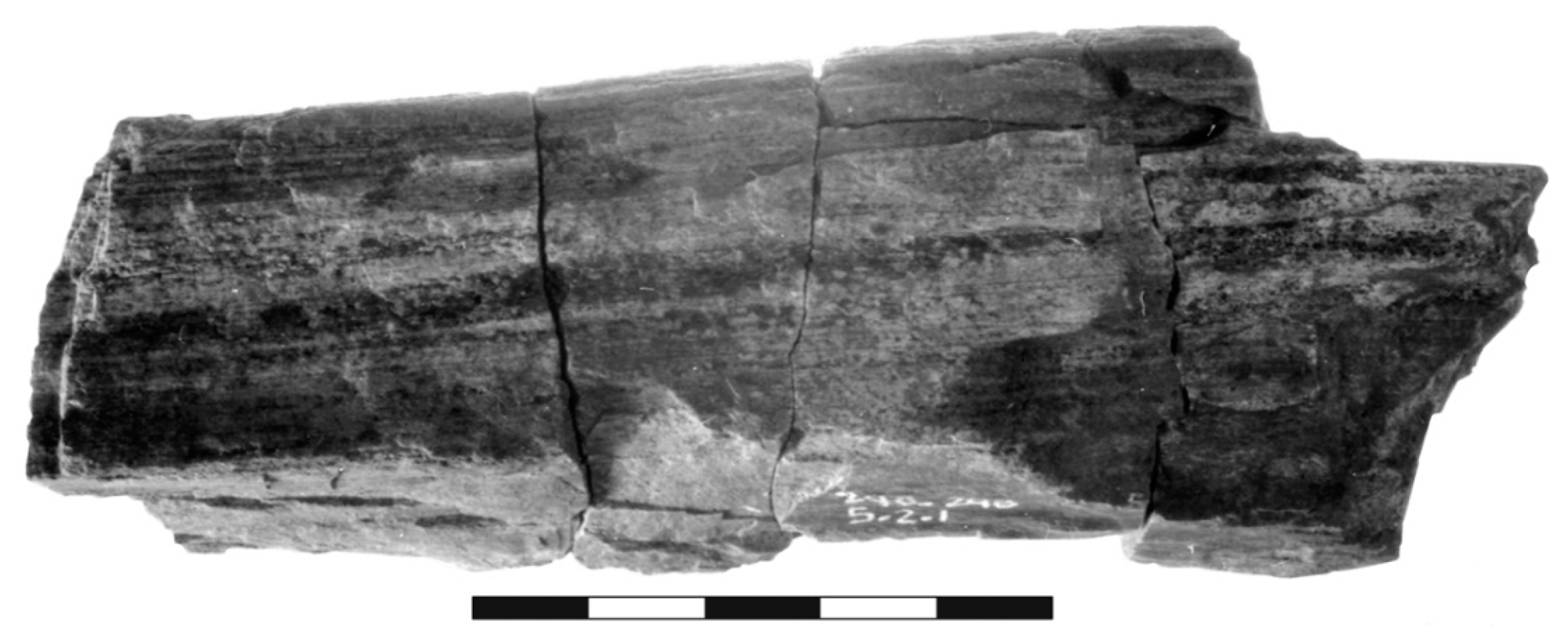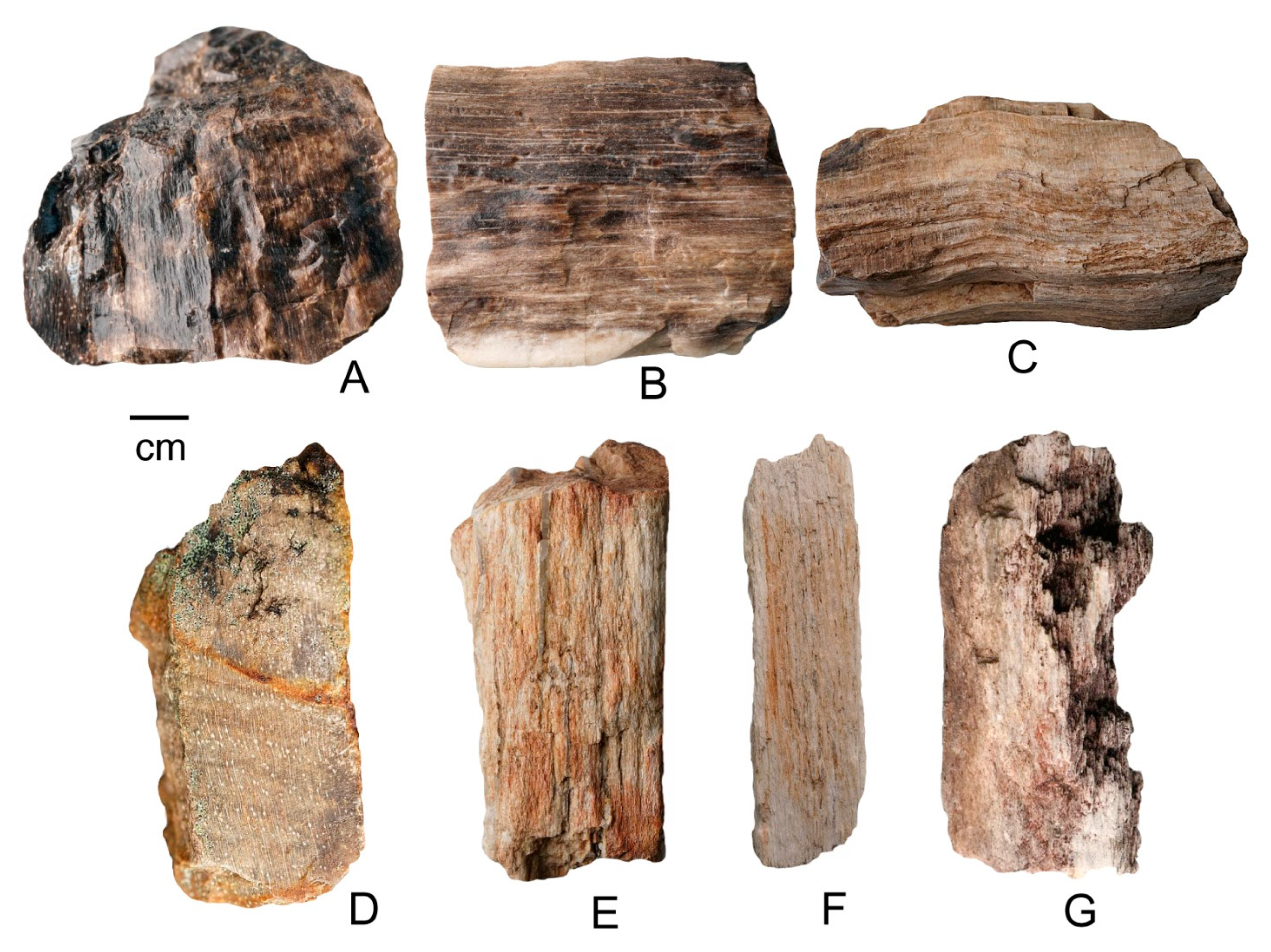New Discovery of Neogene Fossil Forests in Guatemala
Abstract
:1. Introduction
1.1. Location Descriptions
1.2. Las Crucitas Locality
1.3. Salitre Locality
2. Geologic Setting
3. Methods
4. Results
4.1. Salitre Fossil Wood
4.2. Las Crucitas Fossil Wood
5. Discussion
Possible Future Research
Author Contributions
Funding
Acknowledgments
Conflicts of Interest
References
- Inomata, T.; Eberl, M. Stone Ornaments and Other Stone Artifacts. In Life and Politics at the Royal Court of Aguateca. Artifacts, Analytical Data, and Synthesis; Inomata, T., Triadan, D., Eds.; University of Utah Press: Salt Lake City, UT, USA, 2014; pp. 84–117. [Google Scholar]
- Takeshi, I.; Eberl, M. The BarrancaEscondida. In Burned Palaces and Elite Residences of Aguateca:Excavations and Ceramics; Inomata, T., Triadan, D., Eds.; University of Utah Press: Salt Lake City, UT, USA, 2010; pp. 138–148. [Google Scholar]
- Eberl, M. War Owl Falling. Innovation, Creativity, and Culture Change in Ancient Maya Society; University Press of Florida: Gainesville, FL, USA, 2017; pp. 24–129. [Google Scholar]
- Moholy-Nagy, H. The Artifacts of Tikal: Utilitarian Artifacts and Unworked Material. Tikal Report 27, Part B; University of Pennsylvania Museum: Philadelphia, PA, USA, 2003; p. 56 and Figure B: 120f. [Google Scholar]
- Willey, G.R.; Leventhal, R.M.; Demarest, A.A.; Fash, W.L. Ceramics and Artifacts from Excavations in the Copán Residential Zone. In Papers of the Peabody Museum of Archaeology and Ethnology; Harvard University: Cambridge, MA, USA, 1994; Volume 80, p. 261, cat. no. 1–156. [Google Scholar]
- Cunningham, C.G.; Fary, R.W.; Guffant, M.; Laura, D.; Lee, M.P.; Masters, C.D.; Miller, R.L.; Quinones, F.; Peebles, R.W.; Reinemund, J.A.; et al. Earth and water resources and hazards in Central America. In USGS Geological Survey Circular 925; U.S. Government Printing Office: Washington, DC, USA, 1984; p. 40. [Google Scholar]
- Mann, P. Overview of the tectonic history of northern Central America. In Geologic and Tectonic Development of the Caribbean Plate Boundary in Northern Central America, GSA Special Paper 428; Geological Society of America: Boulder, CO, USA, 2007; pp. 1–19. [Google Scholar]
- Álvarex-Gomez, J.; Meijer, P.T.; Martínez-Díaz, J.; Capote, R. Constraints from finite element modeling on the active tectonics of northern Central America and the Middle America. Tectonics 2006, 27, 1–12. [Google Scholar]
- Weyl, R. Geology of Central America, 2nd ed.; GebruderBorntraeger: Berlin, Germany, 1980. [Google Scholar]
- Mustoe, G.E. Density and loss on ignition as indicators of the fossilization of wood. IAWA J. 2016, 37, 98–111. [Google Scholar] [CrossRef]
- Glascock, M.D.; Braswell, G.E.; Cobean, R.H. A systematic approach to obsidian source characterization. In Archaeological Obsidian Studies; Shackley, M.S., Ed.; Springer: Boston, MA, USA, 1998; pp. 15–65. [Google Scholar]
- Stern, W.L.; Eyde, R.H. Fossil forests of Ocú, Panama. Science 1963, 140, 1214. [Google Scholar] [CrossRef] [PubMed]
- Reyes, O.R.; Falcon-Lang, H.; Gasson, P.; Collinson, M.; Jaramillo, C. Fossil woods (Malvaceae) from the lower Miocene (early to mid-Burdigalian) part of the Cucaracha Formation of Panama (Central America) and their biogeographic implications. Rev. Palaeobot. Palynol. 2014, 209, 11–34. [Google Scholar] [CrossRef]
- McFadden, B.J.; Jones, D.S.; Jud, N.A.; Moreno-Bernai, J.W.; Morgan, G.S.; Portell, R.W.; Perez, V.J.; Moran, S.M.; Wood, A.R. Integrated chronology, flora and faunas and paleoecology of the Alajuela Formation, Late Miocene of Panama. PLoS ONE 2017, 20, 1–20. [Google Scholar] [CrossRef]
- Jud, N.; Dunham, J.I. Fossil woods from the Cenozoic of Panama (Azuero Peninsula) reveal an ancient neotropical rainforest. IAWA J. 2017, 38, 366–411. [Google Scholar] [CrossRef] [Green Version]
- Jud, N.; Nelson, C.W. A liana from the lower Miocene of Panama and the fossil record of Connaraceae. Am. J. Bot. 2017, 104, 1–9. [Google Scholar] [CrossRef] [Green Version]
- Nelson, C.W.; Jud, N. Biogeographic implications of Mammeaparamericana sp. nov.from the lower Miocene of Panama and the evolution of the Calophyllaceae. Int. J. Plant Sci. 2017, 241, 241–257. [Google Scholar] [CrossRef]
- Rodriguez-Reyes, O.; Gasson, P.; Thornton, C.; Falcon-Lang, H.J.; Jud, N.A. Panascleroticoxyloncrystallosa gen. et sp. nov.: A new Miocene malpighialean tree from Panama. IAWA J. 2017, 38, 437–455. [Google Scholar] [CrossRef] [Green Version]
- Steffens, G. Changing Climate Factors Forces Desperate Guatemalans to Migrate. Available online: https://www.nationalgeographic.com/environment/2018/10/drought-climate-change-force-guatemalans-migrate-to-us/ (accessed on 20 January 2020).













| Sample | Density g/cm3 | Comments |
|---|---|---|
| Salitre: | ||
| S1-A | 2.20 | Slightly porous |
| S1-B | 2.47 | Slightly porous |
| S1-C | 2.12 | Slightly porous |
| S2-A | 2.10 | Slightly porous |
| S2-B | 2.06 | Slightly porous |
| Las Crucitas: | ||
| LC-A | 2.49 | Non-porous |
| LC-B | 2.35 | Non-porous Contains opal and quartz |
| LC-C | 2.54 | Non-porous |
| LC-D | 2.47 | Non-porous |
| LC-E | 2.45 | Slightly porous |
© 2020 by the authors. Licensee MDPI, Basel, Switzerland. This article is an open access article distributed under the terms and conditions of the Creative Commons Attribution (CC BY) license (http://creativecommons.org/licenses/by/4.0/).
Share and Cite
Mustoe, G.E.; Eberl, M. New Discovery of Neogene Fossil Forests in Guatemala. Geosciences 2020, 10, 49. https://doi.org/10.3390/geosciences10020049
Mustoe GE, Eberl M. New Discovery of Neogene Fossil Forests in Guatemala. Geosciences. 2020; 10(2):49. https://doi.org/10.3390/geosciences10020049
Chicago/Turabian StyleMustoe, George E., and Markus Eberl. 2020. "New Discovery of Neogene Fossil Forests in Guatemala" Geosciences 10, no. 2: 49. https://doi.org/10.3390/geosciences10020049
APA StyleMustoe, G. E., & Eberl, M. (2020). New Discovery of Neogene Fossil Forests in Guatemala. Geosciences, 10(2), 49. https://doi.org/10.3390/geosciences10020049






